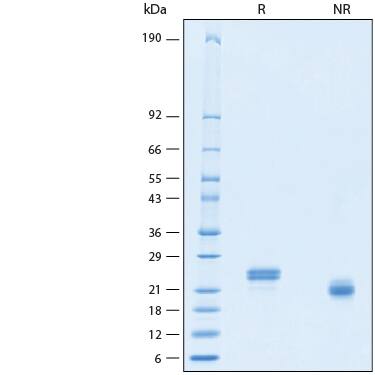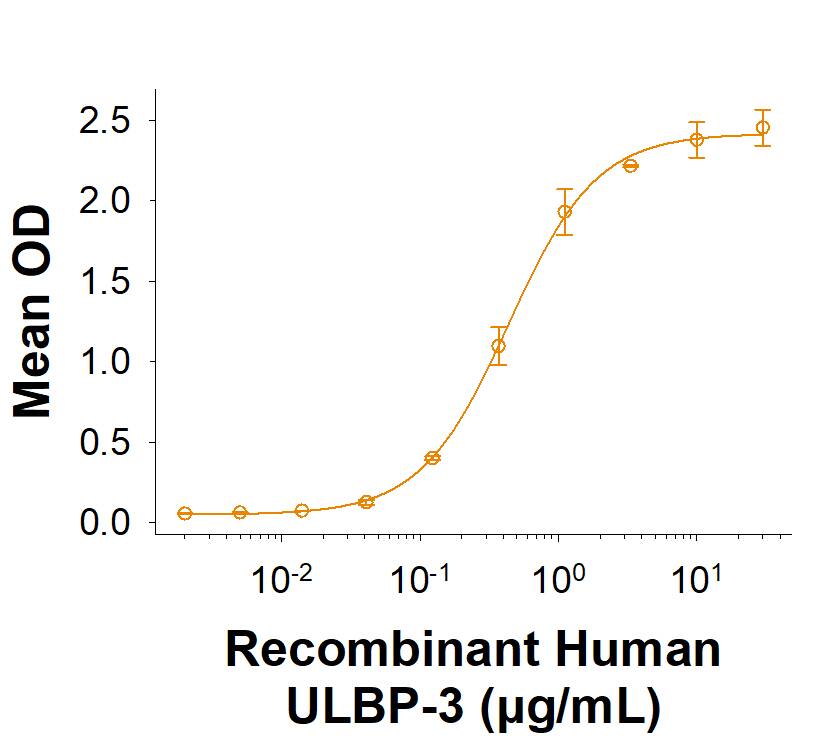Recombinant Human ULBP-3 His-tag Protein, CF
R&D Systems, part of Bio-Techne | Catalog # 11255-UL

Key Product Details
Product Specifications
Source
Gly27-His201, with a C-terminal 6-His tag
Purity
Endotoxin Level
N-terminal Sequence Analysis
Predicted Molecular Mass
SDS-PAGE
Activity
When Recombinant Human NKG2D/CD314 Fc Chimera (Catalog # 1299-NK) is immobilized at 2 µg/mL (100 µL/well), Recombinant Human ULBP-3 His-tag (Catalog # 11255-UL) binds with an ED50 of 0.100-1.20 µg/mL.
Scientific Data Images for Recombinant Human ULBP-3 His-tag Protein, CF
Recombinant Human ULBP‑3 His-tag Protein Binding Activity.
When Recombinant Human NKG2D/CD314 Fc Chimera (1299-NK) is immobilized at 2 µg/mL (100 µL/well), Recombinant Human ULBP-3 His-tag Protein (Catalog # 11255-UL) binds with an ED50 of 0.100-1.20 µg/mL.Recombinant Human ULBP-3 His-tag Protein SDS-PAGE.
2 μg/lane of Recombinant Human ULBP-3 His-tag Protein (Catalog # 11255-UL) was resolved with SDS-PAGE under reducing (R) and non-reducing (NR) conditions and visualized by Coomassie® Blue staining, showing bands at 20-27 kDa.Formulation, Preparation and Storage
11255-UL
| Formulation | Lyophilized from a 0.2 μm filtered solution in PBS with Trehalose. |
| Reconstitution | Reconstitute at 250 μg/mL in PBS. |
| Shipping | The product is shipped at ambient temperature. Upon receipt, store it immediately at the temperature recommended below. |
| Stability & Storage | Use a manual defrost freezer and avoid repeated freeze-thaw cycles.
|
Background: ULBP-3
ULBP-3 is a member of a family of cell-surface proteins that function as ligands for human NKG2D. ULBP-3 has also been described under the names RaeT1N (retinoic acid early transcript), NKG2DL3, and ALCAN-gamma. The name ULBP-3 derives from the original identification of three proteins, ULBP-1, -2, and -3, as ligands for the human cytomegalovirus glycoprotein UL16; they were designated UL16 binding proteins (ULBP). The gene for ULBP-3 resides in a cluster of ten related genes, six of which encode potentially functional glycoproteins. Amino acid sequence identity within this family ranges from 30-60%. These proteins are distantly related to MHC class I proteins, but they possess only the alpha1 and alpha2 Ig-like domains, and they have no capacity to bind peptide or interact with beta2‑microglobulin. Some family members, including ULBP-3, are anchored to the membrane via a GPI-linkage, whereas others have transmembrane domains. ULBP-3 and several other family members are known to bind to human NKG2D, an activating receptor expressed on NK cells, NKT cells, gamma delta T cells, and CD8+ alpha beta T cells. Engagement of NKG2D results in the activation of cytolytic activity and/or cytokine production by these effector cells. The ULBPs are expressed on some tumor cells and have been implicated in tumor surveillance (1-7).
References
- Cosman, D. et al. (2001) Immunity 14:123.
- Kubin, M. et al. (2001) Eur. J. Immunol. 31:1428.
- Sutherland, C. et al. (2002) J. Immunol. 168:671.
- Steinle, A. et al. (2001) Immunogenetics 53:279.
- Sutherland, C. et al. (2001) Immunol. Rev. 181:185.
- Pende, D. et al. (2002) Cancer Res. 62:6178.
- Radosavljevic, M. et al. (2002) Genomics 79:114.
- NKG2D and its Ligands (2002) www.RnDSystems.com.
Long Name
Alternate Names
Entrez Gene IDs
Gene Symbol
UniProt
Additional ULBP-3 Products
Product Documents for Recombinant Human ULBP-3 His-tag Protein, CF
Product Specific Notices for Recombinant Human ULBP-3 His-tag Protein, CF
For research use only

